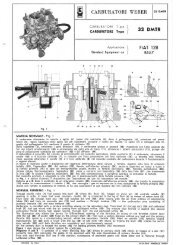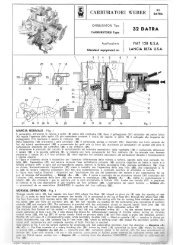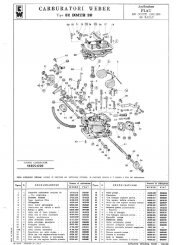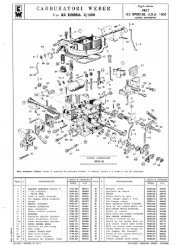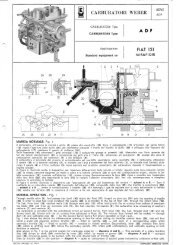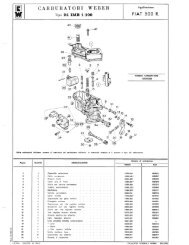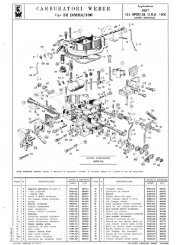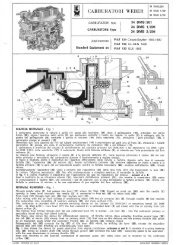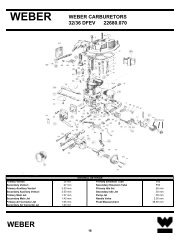Engine Maintenance and Modification Bradley Artigue
FIAT 124 Spider Engine Maintenance + Modification - Artigue.com
FIAT 124 Spider Engine Maintenance + Modification - Artigue.com
- No tags were found...
You also want an ePaper? Increase the reach of your titles
YUMPU automatically turns print PDFs into web optimized ePapers that Google loves.
FIAT 124 Spider<br />
<strong>Engine</strong> <strong>Maintenance</strong> + <strong>Modification</strong><br />
There are two methods you can use to set the initial ignition timing. One is “by the<br />
book,” meaning you set it just like FIAT tells you to <strong>and</strong> lock it down. The second is to<br />
set the ignition timing by ear. There are advantages to both methods – your goal needs<br />
to be to set your engine to the point where it runs best, which may be “by the book”<br />
<strong>and</strong> may be “by ear.”<br />
The “by the book” method is to take the ignition advance information from the black<br />
metal plate inside your hood (if it isn’t there then use the information in table 10 above).<br />
FIAT varied the timing data (to meet emissions regulations) enough that you want to rely<br />
on your car’s data plaque if you can. Using a timing light on the #1 plug wire, start the<br />
engine <strong>and</strong> point the light at the crankshaft position marker. Rotate the distributor so<br />
that the timing is set per the crankshaft marker (see Figure 43). The engine speed may<br />
increase or decrease while setting the timing; adjust the carburetor idle speed screw<br />
accordingly to maintain the correct engine speed.<br />
The “by the ear” method disposes of the need for a timing light. Once your engine is<br />
set to zero degrees BTDC you will advance the distributor to the point at which the<br />
engine speed is no longer increasing. Advancing the distributor improves combustion,<br />
resulting in increased engine speed, but at some point it is too much <strong>and</strong> a reduction<br />
occurs. Once the reduction begins retard the ignition until the engine speed is at the<br />
highest point without missing or puffing. Set the idle speed to the appropriate RPM.<br />
In both cases you want to drive the vehicle <strong>and</strong> check what you’ve done. If you’ve tuned<br />
by the book you need to check the timing again with a light. If you’ve tuned by ear then<br />
make sure engine operation through acceleration <strong>and</strong> deceleration is nice <strong>and</strong> smooth.<br />
The ignition may be advanced too much (remember, the distributor further advances<br />
once it gets moving) <strong>and</strong> require you to retard it a few more degrees to get it all correct.<br />
There is a third method – where you tune to the desired maximum advance. Richard<br />
Ridge submitted the following on my queries about ignition timing:<br />
[What is optimum timing?] It is the timing that allows the car to start readily <strong>and</strong> smoothly accelerate<br />
while also delivering the highest peak torque possible under full load. And of course it also has to meet<br />
whatever emissions limits are required. It is not a single number, rather it is a curve, a smooth timing<br />
advance progression from a few hundred rpm to the rpm at peak torque.<br />
The actual numbers depend on cam timing, compression, head work, induction <strong>and</strong> exhaust<br />
configuration. Accuracy requires dyno work or trial <strong>and</strong> error on the street. Looking at the factory curves<br />
for different engine configurations is a good way to start.<br />
For a race engine that has no real starting, drivability or emissions restrictions, the answer does boil<br />
down to a single number. Others have suggested that for TC engines in typical competition trim, the<br />
number is in the 35-38 degree BTDC range.<br />
Given this information, if you want to seek out a specific degree of maximum advance<br />
you need to determine the maximum advance of your distributor, do a little math, <strong>and</strong><br />
figure out your initial timing. If you want 35 degrees of advance <strong>and</strong> have a distributor<br />
with 30 degrees of total advance, your initial timing will be 5 degrees. Sounds simple,<br />
right? Trial, error, <strong>and</strong> patience will pay off if this kind of accuracy interests you.<br />
71



